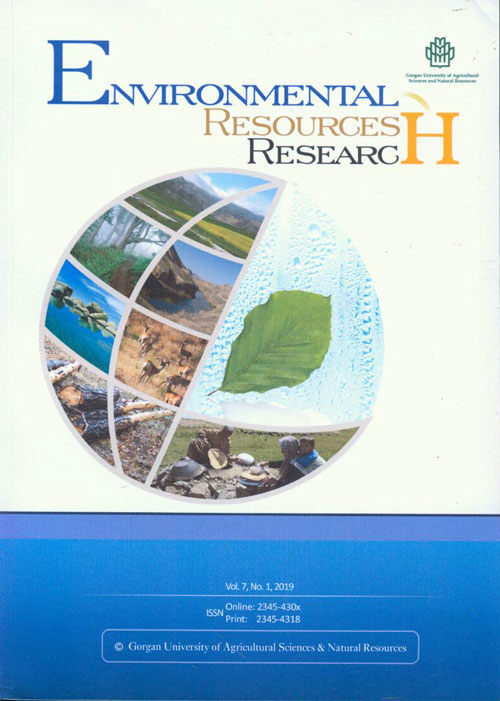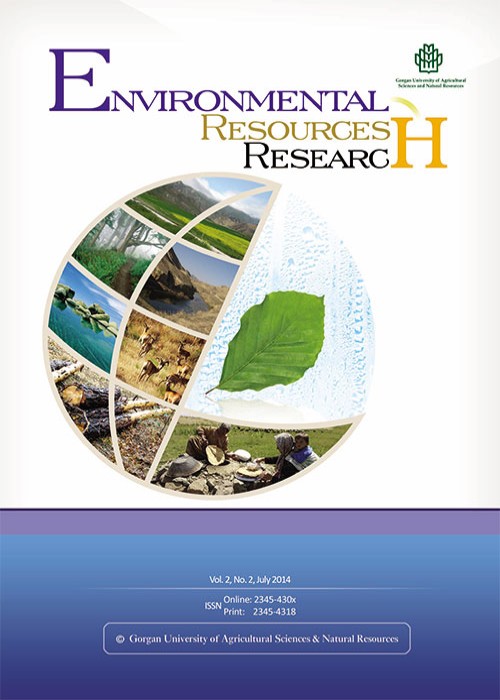فهرست مطالب

Journal of Environmental Resources Research
Volume:7 Issue: 2, Summer-Autumn 2019
- تاریخ انتشار: 1398/11/22
- تعداد عناوین: 7
-
-
Pages 79-86
Dyes in wastewater generate one of the main sources of environmental pollution, and treatment of this pollution is absolutely ncessary for protection of the environment. New economical and environmentally friendly approaches are needed to remove dyes from aqueous solutions. The purpose of this study was to use chitin nanofibers, as a valuable natural material, to remove bromocresol green dye. The effects of effective variables such as pH (2-7), adsorbent dosage (0.25-2.5 gram), initial concentration (0.2-2 mg.l-1), temperature (20-45 °C) and contact time (5-30 min) were investigated for color removal. The results showed that color adsorption is pH dependent and pH=6 was selected as the optimal value. Given that at the concentration of 0.4 mg.l-1, 92.75% of the color was removed, this concentration was chosen as the optimal case. By taking into account the cost of the absorbent, 1.5 gram was selected as the optimal dosage for bromocresol green. A contact time of 10 minutes at 25°C was considered as the best for these two parameters, which indicates the short duration of this treatment. One way anova and Duncan test in Excel and SPSS software indicated a significant effect of the parameters on removal of dye. The results showed that chitin nanofibers have significant influence on the removal and reduction of bromocresol green from aqueous solutions, and thus wastewaters containing other colors. This process can be replicated in diluted wastewater treatments in textile industry without requiring high pressures and temperatures
Keywords: Bromocresol green, Chitin nanofibers, Aqueous solution, Dyes, Adsorption -
Pages 87-104
The purpose of this study was to document changes in indices simulated by the ensemble application of Coupled Model Inter-comparison Project CMIP5 and CMIP3 when analyzing impacts of climate change on catchment rainfall indices in sub-basins of Hamedan province, west of Iran. The analysis of the precipitation indices consisted of simple rainfall intensity, very heavy rainfall days, maximum one-day rainfall, and rainfall frequency. I investigated the relative change in three rainfall indices based on general circulation models (GCMs) under a mixture of greenhouse gas emission scenarios A1B and B1, RCP8.5 and RCP8.5 for two future periods 2020–2045 and 2045-2065. Results showed that each of the rainfall indices differed in stations under the three GCMs models (GIAOM, MIHR, MPEH5) and emission scenarios A1B, B1, RCP2.5, and RCP8.5. Relative 50y change for future periods 2046–2065 varied from -9.93% to 25% for daily intensity index, from 20.71% to 25.9% for very heavy rainfall days and from -15.71% to 13% for annual rainfall depth in the study area. Rainfall indices projection of sum of wet days, days>1mm, and maximum one-day rainfall showed decrease under the scenarios B1 and A1B and also sum of wet days, simple daily intensity, and heavy rainfall days>10 decreased under the RCP2.6.
Keywords: Climate change, Rainfall indices, Uncertainty, LARS-WG, Hamedan province1 -
Pages 105-116
Agricultural and industrial activities have affected the strategies of groundwater quality management during the past decades. Assessment of groundwater vulnerability potential is currently one of the most important devices in water resources management. During recent years, various methods for assessment of vulnerability potential have been developed such as mathematical models, statistical procedures and overlapping and ranking techniques. DRASTIC and SINTACS models are the two most popular overlapping index methods, utilized recently. Vulnerability potential evaluation of groundwater in Evan Plain was implemented applying DRASTIC and SINTACS models. Hydrogeological parameters including aquifer recharge, water table depth, hydraulic properties of the aquifer, surface topography and the soil properties were analyzed, utilizing the geographical Information system (GIS) to evaluate the susceptibility of the study area to groundwater pollution. The major portion of the Evan Plain has low to very low potential in DRASTIC model, whereas SINTACS model shows low to moderate potential of pollution. Sensitivity analysis of the models revealed that the topography parameter has the highest effect in vulnerability potential. Nitrate concentration was as the model calibration index. Nitrate concentration ranged between 8 to 33 mg/l in most parts of the Evan Plain, similar to SINTACS model results.
Keywords: Groundwater, Pollution potential, Evan Plain, DRASTIC model, SINTACS model -
Pages 117-128
Changes in rainfall have significant effects on vegetation of an area, especially in arid and semi-arid regions. Nowadays, the vegetation can be assessed using indices derived from satellite imagery and remote-sensing techniques. The aim of this study was to evaluate the effect of rainfall on vegetation and to compare NDVI and RVI indices. The study area is Malekshahi, a city with an area of 1165 km2, located in the northeast of Ilam Province. The statistical data of 10 rain gauge stations in the region were used to investigate the rainfall fluctuations during the years 2000 and 2014. ETM images of Landsat satellite were used for the years 2000, 2007 and 2013. To evaluate the vegetation, NDVI and RVI were assessed using ENVI 4.7 software. The results showed that the highest and lowest rainfalls were 600 and 211 mm in 2000 and 2014, respectively. Comparison of the two vegetation indices showed that the NDVI index with the overall accuracy of above 70% has the highest capacity to separate the semi-dense forests from the dense ones. However, the RVI index showed a greater efficiency to separate the thin forests. The NDVI index had the highest correlation with precipitation compared to RVI index. Thus, NDVI is an appropriate parameter to assess the changing process of precipitation in the study area.
Keywords: Rainfall, Overall Accuracy, RVI, NDVI, Malekshahi1 -
Pages 129-135
The Water-Energy-Food nexus (WEF) has been initially introduced in the international community as an adaptive management approach in response to climate change. This study aims to review and analyze the existing literature on WEF nexus approach at different scales and to suggest supplementary ideas for better applicability of WEF nexus framework in integrated watershed management. In terms of geographical distribution, the study covers Asia (Central, South, Southeast, and East), Australia, Africa (North, South, and East), North America (USA, Mexico, and Canada), South America (Brazil), Europe (UK, Italy, Germany, Spain, Sweden, and Greece), and Oceania. For this, 203 articles and documents were found dealing with WEF nexus. Interest over time in WEF nexus was examined from 2011 to 2019 in these regions. The review showed 10 articles had a close linkage with water–food, 49 with water-energy, 119 with water-energy-food, six with water-foodenergy-ecosystems, five with water-energy-land-food, three with food-energy-environment, three with water-soil-waste and eight with climate. We propose ecosystem services and other important commodities like soil be considered in future nexus relevant studies. Towards this, the soil-water-energy-food (SWEF) nexus is introduced as a useful approach towards higher sustainability and adaptive management at the watershed scale.
Keywords: Adaptive Management, Integrated Watershed Management, Soil-Water-EnergyFood Nexus, Trade-Offs, Watershed Ecosystem * -
Pages 137-146
Vetiver grass (Chrysopogon zizanioides L.) is a multi-purpose plant which plays important role in soil conservation due to its deep roots. Since the soil in most regions of Iran is poor in organic matter, it is necessary to apply proper soil amendments to optimize plant growth. A completely randomized factorial experiment with three replications was done in the research greenhouse of Malayer University to evaluate the combined effect of zeolite and compost on quantitative (i.e. shoot dry weight and root dry weight) and qualitative (i.e. chlorophyll a and b, carotenoids, relative water content, and proline) characteristics of Vetiver grass. Compost was added at four levels of zero (control), 20, 40, and 60 percent by volume and zeolite was added at five levels of zero (control), 10, 20, 30, and 40 g to the soil (five kg) of the pots containing scions. The results demonstrated that the applied treatments had a significant effect on all the measured traits. The concentrations of chlorophyll a and b and carotenoids significantly increased (p≤ 0.05) under the effect of different levels of compost and zeolite. Although the leaf relative water content (RWC) increased in some of the treatments (Z2C3, Z2C4, Z4C1, and Z5C3), in general, it decreased significantly compared to the control treatment. In addition, the shoot and root dry weights increased significantly under the effect of all fertilizer levels. In our study applying fertilizers had a positive effect on the quantitative and qualitative performance of Vetiver grass.
Keywords: Clinoptilolite, Improvement, Fertilizers, Rangeland, Compost -
Pages 147-164
Proper modeling of rainfall-runoff is essential for water quantity and quality management. However, comprehensive evaluation of soft computing techniques for rainfall-runoff modeling in developing countries is still lacking. Towards this end, in the present study two new soft computing techniques of genetic programming (GP) and M5 model tree were formulated for daily streamflow prediction. Firstly, the daily meteorological and hygrometric data including rainfall, temperature, evapotranspiration, relative humidity and discharge were collected for the years 1970 - 2012 throughout Amameh Watershed in Tehran, Iran. Secondly, the input variables were determined using cross-correlation and then 62 different scenarios were developed. Thirdly, the data were standardized in the range of zero to one. Finally, performance of the scenarios was assessed using the mean square error (MSE), root mean square error (RMSE) and mean absolute error (MAE). Totally, 80 and 20 percent of instances were used for training and testing, respectively. The results showed that the scenario number 54 was the best using both GP and M5 model tree techniques. However, GP showed much better performance than M5 model tree with MSE, RMSE, and MAE values of 0.001, 0.031 and 0.009 for training and 0.001, 0.032 and 0.009 for testing, respectively. The scenario 54 had eight inputs including rainfall, discharge, and delay for two days, temperature, evapotranspiration and relative humidity.
Keywords: Genetic programming, Model development, M5 model tree, Scenario analysis, Streamflow prediction


